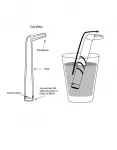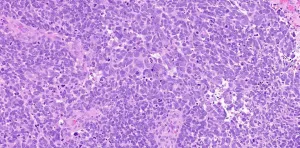Picky neurons
In the visual thalamus, neurons are in contact with both eyes but respond to only one
2021-06-18
(Press-News.org) The visual thalamus is classically known to relay visual stimuli coming from the retina to the cerebral cortex. Researchers from the Max Planck Institute of Neurobiology now show that although neurons in the mouse visual thalamus connect to both eyes, they establish strong functional connections only with one retina. These results settle partly contradictory results of earlier studies and demonstrate how important it can be to complement structural data with functional analyses.
We have two eyes, but perceive the tree in front of us only once. Our brain therefore has the complicated task of combining the information of both eyes in a meaningful way. To do so, visual stimuli first travel from the retina via so-called ganglion cells to the visual thalamus. There, the information does end up in clearly defined areas - depending on the type and eye-of-origin of retinal ganglion cells transporting the visual stimuli. Signals from the right and left eye are thus clearly separated in the visual thalamus and independently transmitted to the visual cortex. Only in this brain region, the incoming information is combined - at least according to a long-standing theory.
However, recent anatomical studies describe that a surprising number of neurons in the mouse visual thalamus has contact to both eyes. Does the separation of 'left eye' and 'right eye' information channels not hold true in mice? Scientists from Tobias Bonhoeffer's department wanted to shed more light on this newly raised question. They further developed an optogenetic method, so that they could activate ganglion cells of both eyes successively with light of different colors and measure the corresponding electrical responses in a thalamic cell.
This analysis shows that indeed a multitude of neurons in the visual thalamus receive input from both retinas. But interestingly, there are only very few cells in which the signal strengths of both eyes are similar. In most cells, one eye dominates with a much higher input strength. The weak signals from the non-dominant eye did not trigger an action potential in the experiment and thus seem to not play a major role in the processing of visual information. "With these results, we can explain the contradictory findings of previous research," says Tobias Rose, who led the study. "The neurons in the visual thalamus do form connections with both eyes, but are functionally monocular or, so to speak, one-eyed. That means that only the signal strength of one eye is high enough for the cells to respond."
Selection of input
The spatial arrangement of retinal and thalamic cells and the resulting connection possibilities alone cannot explain the functional monocularity. Instead, the scientists showed that even with equal access to both eyes, thalamic cells establish functional connections with only one eye. Accordingly, there is a clear selection of the input source. In addition, the contact sites with the dominant eye seem to strengthen, while those of the non-dominant eye remain in an immature state.
Future studies aim to reveal how the dominant eye is determined and whether this mechanism also applies to different retinal ganglion cell types. Another interesting research topic are the immature contact sites. At first glance without obvious function, the question arises whether they could be activated when needed - and thus play a role, for example in amblyopia, a form of visual impairment.
With their study, the researchers prove that the mouse visual thalamus indeed transfers visual information in separate channels - presumably similar to humans. In addition, it becomes clear that anatomical data sets may be interpreted with caution: Just because neurons are in contact with each other does not mean that they communicate extensively.
INFORMATION:
Original publication
Joel Bauer*, Simon Weiler*, Martin H.P. Fernholz*, David Laubender, Volker Scheuss, Mark Hübener, Tobias Bonhoeffer, Tobias Rose (* co-first)
Limited functional convergence of eye-specific inputs in the retinogeniculate pathway of the mouse
Neuron, online June 18, 2021
[Attachments] See images for this press release:

ELSE PRESS RELEASES FROM THIS DATE:
2021-06-18
June 18, 2021 - At least so far, the currently limited research base does not establish that cannabis has additional adverse effects on brain development or functioning in adolescents or young adults with attention-deficit/hyperactivity disorder (ADHD), concludes a review in the July/August issue of Harvard Review of Psychiatry. The journal is published in the Lippincott portfolio by Wolters Kluwer.
While ADHD is clinically defined to have impairments in cognitive functioning, cannabis use by itself is also associated with cognitive impairments: "[T]he evidence to date does not clearly support either an addictive effect or an interaction - whether protective ...
2021-06-18
After graduating or leaving college, many students face a difficult choice: Try to pay off their student loans as fast as possible to save on interest, or enroll in an income-based repayment plan, which offers affordable payments based on their income and forgives any balance remaining after 20 or 25 years.
There are pros and cons to each option, and trying to discern the better path can be daunting. That's why University of Colorado Boulder's Yu-Jui Huang and Saeed Khalili, a former graduate student in financial mathematics, along with Dublin City University's Paolo Guasoni, decided to throw a little mathematical ...
2021-06-18
HOUSTON - (June 18, 2021) - To boost employees' creativity, managers should consider offering a set of rewards for them to choose from, according to a new study by management experts at Rice University, Tulane University, the University of North Carolina at Greensboro and National Taiwan Normal University.
The study, co-authored by Jing Zhou, the Mary Gibbs Jones Professor of Management and Psychology at Rice's Jones Graduate School of Business, is the first to systematically examine the effects of reward choice in a field experiment, which was conducted in the context of an organizationwide suggestion ...
2021-06-18
MINNEAPOLIS/ST. PAUL (06/18/2021) -- University of Minnesota Medical School researchers determined that the common blood pressure medication, losartan, is not effective in reducing hospitalization for mildly-ill COVID-19 outpatients.
In the multicenter, randomized, double-blinded clinical trial, non-hospitalized patients recently diagnosed with COVID-19 were given either losartan or a placebo and monitored for 15 days. The study's results, which were published in END ...
2021-06-18
Left hands and right hands are almost perfect mirror images of each other. But whatever way they are twisted and turned, they cannot be superimposed onto each other. This is why the left glove simply won't fit the right hand as well as it fits the left. In science, this property is referred to as chirality.
Just like hands are chiral, molecules can be chiral, too. In fact, most molecules in the cells of living organisms, such as DNA, are chiral. Unlike hands, however, that usually come in pairs of left and right, the molecules of life almost exclusively occur in either their "left-handed" or their "right-handed" version. They are homochiral, as researchers say. Why that is, is still not clear. But ...
2021-06-18
SAN ANTONIO (June 18, 2021) -- Researchers from The University of Texas Health Science Center at San Antonio (UT Health San Antonio) and colleagues worldwide describe a new science-based intervention for hiccups in a research letter published June 18 in the journal JAMA Network Open.
In the publication, the scientists coined a new term for the intervention: the "forced inspiratory suction and swallow tool," or FISST. The team also reported the results of a survey of 249 users who were asked whether it is superior to hiccup home remedies such as breathing into ...
2021-06-18
An international team led by researchers at Princeton University has uncovered a new pattern of ordering of electric charge in a novel superconducting material.
The researchers discovered the new type of ordering in a material containing atoms arranged in a peculiar structure known as a kagome lattice. While researchers already understand how the electron's spin can produce magnetism, these new results provide insights into the fundamental understanding of another type of quantum order, namely, orbital magnetism, which addresses whether the charge can spontaneously flow in a loop and produce magnetism dominated by extended orbital motion of electrons in a lattice of atoms. Such orbital currents can produce unusual quantum ...
2021-06-18
Cancer cells have an uncanny ability to evolve and adapt to overcome the treatments used against them.
While patient survival has been extended by modern drugs that block the production or action of male hormones that fuel prostate cancer -- androgen receptor inhibitors such as enzalutamide, apalutamide, darolutamide, and abiraterone -- eventually these drugs stop working. At that point, a patient's disease is considered incurable, or what doctors call metastatic, castration-resistant prostate cancer.
In a new study, a team of researchers led by Joshi Alumkal, M.D., who ...
2021-06-18
BIRMINGHAM, Ala. - Will a reduction in tau protein in brain neurons protect against Parkinson's disease and Lewy body dementias?
A new study, published in the journal eNeuro, suggests the answer is no. If this is borne out, that result differs from Alzheimer's disease, where reducing endogenous tau levels in brain neurons is protective for multiple models of the disease -- which further suggests that the role of tau in the pathogenesis of Lewy body dementias is distinct from Alzheimer's disease.
Both Parkinson's disease dementia and Lewy body dementia are characterized by intracellular aggregates of misfolded alpha-synuclein protein in brain neurons, and the two diseases together are the second most common cause of neurodegenerative dementia after ...
2021-06-18
Lake Victoria, which came under the spotlight in 2004 by the documentary "Darwin's nightmare", is not only suffering from the introduction and commercialisation of the Nile perch. A study lead researchers from the University of Liège (Belgium) has highlighted other worrying phenomena, particularly climatic ones, which have an equally important impact on the quality of the lake's waters.
Located in East Africa, just south of the Equator, Lake Victoria is the source of the Nile and is the largest tropical lake in the world. With a surface area of 68,800 km² (twice the size of Belgium), it is considered to be one of the largest water and fishery resources in East Africa, supporting more than 47 million people in the three neighbor countries ...
LAST 30 PRESS RELEASES:
[Press-News.org] Picky neurons
In the visual thalamus, neurons are in contact with both eyes but respond to only one




